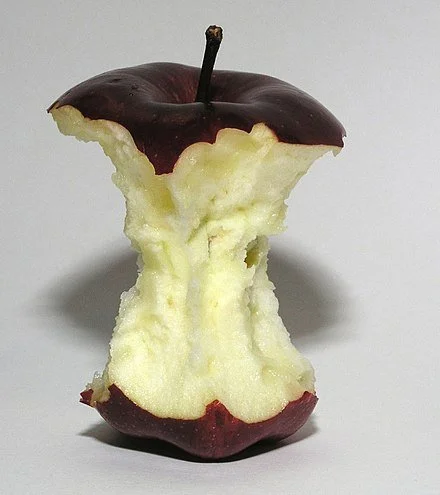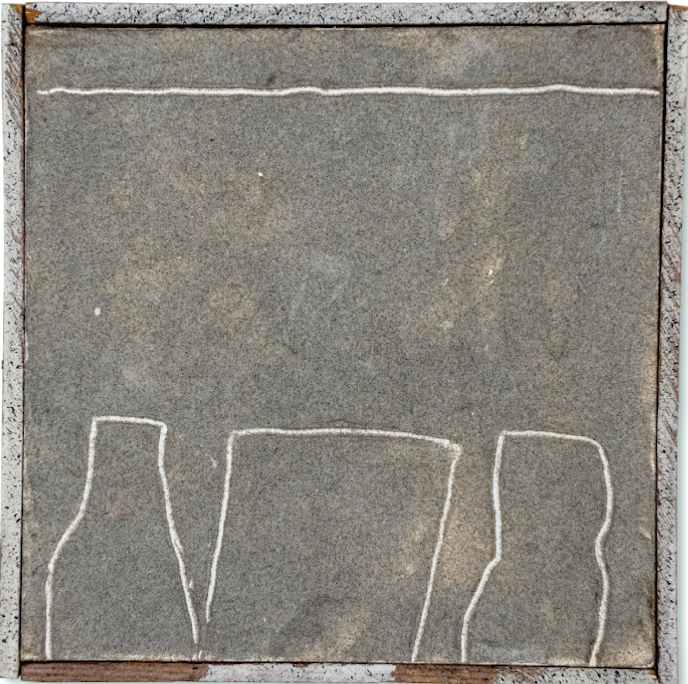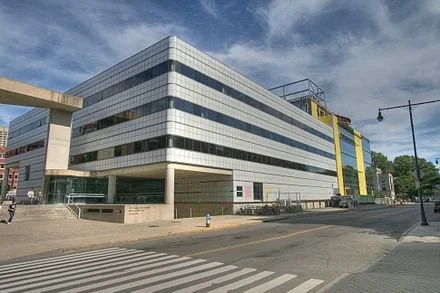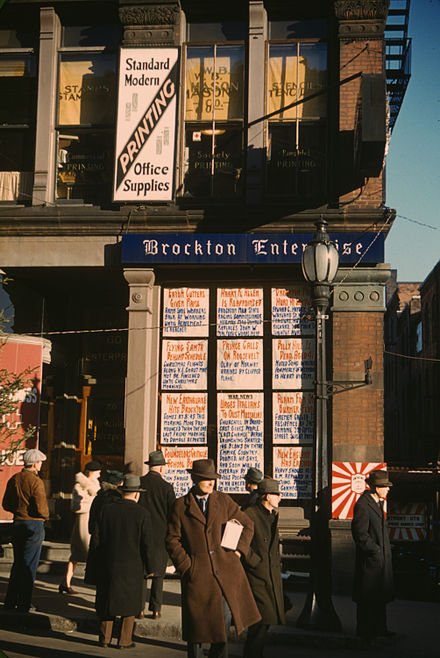
Must be patrolled
“Island of Endangered Species” (oil, mixed media, fabric on panel), by Donald Saaf , his show “Peaceable Kingdom: The Art of Donald Saaf,’' at the Cahoon Museum of American Art, Cotuit, Mass., through Dec. 23. He lives in the Saxtons River section of Rockingham, Vt.
— Photo by Mr. Saaf
The museum says Mr. Saaf:
"{E{}xplores the subtle line between fine art and folk art in paintings that are heartwarming and approachable. His large-scale paintings and collages draw upon his memories of nature, family and community from his life in rural Vermont.’’
North of the immigration zone?
New Hampshire’s Franconia Range. The state’s, er, rigorous climate is uninviting for some immigrants.
“Immigration, of course, in New Hampshire is - it's not something that you see every day. It's not like talking about it in Texas, where people have a much more explicit sense of it.’’
Evan Osnos (born 1976), American journalist and book author
Sam Pizzigati: Time to close the huge IRS audit gap that favors the rich
IRS logo
Read about New England’s richest towns, and how they got that way.
Via OtherWords.org
BOSTON
In 2020, U.S. households annually making over $1 million faced fewer tax audits than households with incomes low enough to qualify for the Earned Income Tax Credit. That had never happened before.
In part, you can blame the Trump administration. But conservatives in Congress actually gave Trump his tax-cutting playbook, as a new Americans for Tax Fairness report makes clear.
Ever since 2010, these right-wing lawmakers have been squeezing the IRS budget, forcing the agency “to drastically pull back on auditing the ultra-wealthy.” Between 2010 and 2020, audits on millionaires dropped a whopping 92 percent.
The super rich have taken full advantage. Nearly a thousand taxpayers making over $1 million a year, Sen. Ron Wyden (D.-Ore.) points out, haven’t even bothered “to file tax returns over multiple recent years.”
Thanks to the Inflation Reduction Act President Biden signed, the IRS gained an $80 billion increase in funding last year. Wyden, who chairs the Senate Finance Committee, wants to see the IRS use that money to increase the audit rate on America’s richest.
But Republicans are pushing to chop IRS funding by $67 billion. That cut, Americans for Tax Fairness calculates, would leave the nation right back where the Trump gang left it: with millionaires getting audited less than 1 percent of the time.
We should be resisting those auditing cuts. And besides cracking down on tax cheats, we need to close the wide constellation of loopholes that help the richest Americans legally sidestep any significant tax bill.
One example? The abuse of nonprofit donations.
Most of us hear the word “nonprofit” and think of the Red Cross or some other familiar charity. These traditional charities fall under section 501(c)(3) of the U.S. tax code.
Other nonprofits — most notably those that come under the tax code’s 501(c)(4) — can engage in activities that have next to nothing to do with providing charitable services. They can own companies indefinitely, as Forbes details, and benefit private individuals. They can lobby lawmakers as much as they want and “get directly involved in politics.”
This flexibility that C4s offer became particularly attractive to America’s deepest pockets in 2015.
Lobbyists bankrolled by the billionaire Koch family wiggled into the tax law that year a charming little loophole that lets the rich take shares of stock they own that have appreciated handsomely and pass them to C4s — without having to pay either a gift tax or a capital-gains tax on the share transfer.
The C4s receiving these hefty gifts of shares, Forbes adds, “can then sell the stock, capital gains tax–free, or hold on to it indefinitely, reaping the dividends.”
Thanks to this loophole, note investigative journalists Judd Legum and Tesnim Zekeria, billionaires like Charles Koch can now use their allied C4s “to spend as much money as they want on political campaigns without disclosing their spending or paying taxes.”
Billionaires should be paying taxes like the rest of us to support schools, health care, and the like. Instead, this handy and inequitable loophole leaves billionaires with the wherewithal to buy still more private jets, trinkets, and mansions — and our democracy.
Blank political checks for billionaires like Charles Koch have no place in a country striving to become a more equal place. So let’s fund the IRS, close the loopholes, and conduct those audits. Now!
Sam Pizzigati, based in Boston, co-edits Inequality.org at the Institute for Policy Studies. His books include The Case for a Maximum Wage and The Rich Don’t Always Win.
‘A kiss that never ends’
“A Burst of Light (Red)’’ (hair, embodied knowledge, ancestral recall, audacity of survival, bobby pins), by Providence-based Nafis M. White, in the show “Paint the Town Red,’’ at Cade Tompkins Projects, Providence, Nov. 4-Dec. 31.
Edited from the gallery’s description:
“White dives into the depths of the autumnal energy, bathing the gallery in red in honor and celebration of the Goddess Sekhmet, the Warrior, the Sensualist, the Destroyer, the Lover, the Healer.
“In ‘Paint the Town Red,’ White premieres new paintings, works on paper, performance and new iconic Oculus works. As viewers go deeper into the sanctuary, the darkness surrounds, red lighting illuminating the pathways forward, Afro House pulsating through the space. What happens in the dark stains the lips of the revelers. ‘A kiss that never ends, effervescent energy that vibrates towards intellectual climax, this is what I'm after….catharsis, power, partnership and release,’ says White.
“Bodies of work on display also include ‘Hidden Topographies,’ which employs crewel embroidery and needlework to at once obscure and reimagined written text; and ‘God Helps Those Who Help Themselves,’ continuing White’s inquiry into the life story of Emmanuel ‘Manna’ Bernoon, a freed slave who founded Providence’s first restaurant, in 1736, an oyster and ale house. For this work, White sourced local oysters, cleaned and dried the shells and imbued them with gold leaf ‘to honor the beauty, resilience and legacy of a people.’’’
Apple agritourism
Text excerpted from a The New England Historical society article
“Trying to pick six historic apple orchards in New England may be a fool’s errand. As Maine apple expert John Bunker explains, the notion of a commercial orchard is relatively modern.
“‘At a certain point, everyone had an orchard,’ Bunker told the New England Historical Society. ‘Everyone lived on a farm, and every farm had an orchard.’
“In the 1920s, a New Hampshire farmer came up with the idea of bringing tourists from Boston to pick their own apples in the fresh air and sunshine. The idea took hold. Today, 200-year-old farms are weathering developers (if not the weather) by diversifying with farm-to-table meals, cider, kids’ play areas, ready-to-eat food, hayrides, sleigh rides, corn mazes and even seasoned firewood.
“Agritourism today is just as much a feature of the New England landscape as history tourism. Here, then, are six historic apple orchards, one in each New England state.’’
To read the whole article, please hit this link.
Waiting for a freeze
“Autumn Leaves’’ (oil on canvas), by Sir John Everett Millais (1829–1896)
Adapted from Robert Whitcomb’s “Digital Diary,’’ in GoLocal24.com
“Indian summer is like a woman. Ripe, hotly passionate, but fickle, she comes and goes as she pleases so that one is never sure whether she will come at all, nor for how long she will stay.”
―The weirdly sexist opening of the novel Peyton Place (1956), by Grace Metalious (1924-1964), who based the once-thought nearly obscene novel on what she saw and heard living in New Hampshire, with Gilmanton considered the model for Peyton Place.
We’re waiting for a freeze in a few days to send most of the leaves from the trees falling in one fell swoop, as often happens a few days before Halloween.
Years ago, this would be followed by air suffused with the sweet smoke from innumerable leaf-pile fires. Despite the bluish air pollution, worsened by the atmospheric inversions common in the fall, we always looked forward to leave-burning season. Leaf-burning is now banned in many communities, mostly for public-health reasons.
— Photo by David Hill
As everything else slows down -- even without a frost the grass grows more slowly -- the squirrels seem to scurry faster amidst the acorn caps. (They’ve stashed away most of the acorns (oak nuts).)
I’m looking forward to that mild, still, dry, hazy and pleasantly melancholy time called Indian Summer that follows the first real freeze. It grants the best walking weather of the year. But get out those light boxes to treat your SAD.
High Street in Gilmanton, N.,H., in 1910.
Mount Norwottuck in the Mount Holyoke range, on the border between the towns of Amherst and Granby, Mass.
— Photo by Andy Anderson
Chris Powell: Why it’s so hard to believe that crime is down in Conn.; social disintegration continues
MANC HESTER, Conn.
Few people in Connecticut have the impression that there recently has been less crime in the state. Most people seem to feel that crime here is exploding.
But last week the state Department of Emergency Services and Public Protection -- the state police -- reported that crime in Connecticut is down on an annual basis: 4 percent overall, with a 3 percent reduction in violent crime, a 13 percent reduction in murders, and an 18 percent reduction in robberies.
What explains the dichotomy?
The leader of the Republican minority in the state House of Representatives, Vincent Candelora, of North Branford, interviewed last week by WTIC-AM1080's Will Marotti, said plainly of the crime report, "Nobody believes those numbers."
There may be a good reason not to believe them. After all, four months after an outside audit concluded that state troopers may have issued thousands of fake traffic tickets, perhaps to sabotage an effort to discern racial discrimination in traffic enforcement, the state police still haven't produced an explanation. While Gov. Ned Lamont hasn't publicly criticized anyone about the scandal, he is seeking replacements for the department's top two executives.
But the public's disbelief and the loss of state police credibility don't mean that the crime numbers have been falsified like the traffic tickets. The disbelief may arise from other factors.
xxx
Social disintegration is worsening and becoming more distressing even if it doesn't always result in arrests and crime data.
More children than ever are skipping school and more parents than ever are letting them. Even before schools were closed during the COVID, epidemic student performance was crashing, diminishing young people's job qualifications and earning potential, while Connecticut's manufacturers complain that they can't find skilled workers for thousands of jobs.
Homelessness and drug abuse are rising again. Contempt for law and decency seems to be rising as well, with crimes becoming more brazen even if not more numerous. Car thefts and shoplifting are up, and reckless and discourteous driving and road rage seem to have exploded.
Severe inflation has made times harder and people seem more confrontational. Last week alone Connecticut police officers shot and killed three men in separate incidents, all appearing to involve men who threatened an officer with guns.
Last week the state's biggest teacher union complained again about disrespectful students, and the Connecticut Hospital Association complained that patients and visitors increasingly are assaulting hospital staff. But arresting students and maintaining order and learning in schools have become politically incorrect, and while the hospitals said they aren't going to take the abuse anymore, let's see if they start to call the police.
Connecticut may remain, as Governor Lamont said in response to the crime report, "one of the safest states in the country," but the comparison with other states is little consolation. Connecticut long was better than other states, and now many people feel as if the state is falling apart, even if not quite as fast as the rest of the country.
Maybe the crime report and public perceptions don't really conflict as much as they seem to. For the report covers calendar 2022 and social disintegration may have worsened greatly in the 10 months since.
And maybe journalism has made social disintegration seem worse than it is. For the substance of journalism in the state has been much reduced in recent years as its audience has been fractured by social media and civic engagement has declined. These trends have diminished the profitability of news organizations and caused them to eliminate staff, especially for matters of government, and to devote more coverage to crime, accidents, and fires, which is usually easier and less expensive while it crowds out more important news.
"If it bleeds, it leads" long has been the rule for local television news and it is being followed more diligently. This may hold on to audiences but also may give a misleading impression that encourages people to move to Florida. But that state has plenty of crime, accidents and fires, too, even if victims there don't freeze to death.
Chris Powell has written about Connecticut government and politics for many years (CPowell@cox.net).
Lawrence S. DiCara: Kill Social Security too?
The Portland Soldiers and Sailors Monument sits in the center of Monument Square, on the former site of Portland's 1825 city hall. Dedicated on Oct. 28, 1891, it honors "those brave men of Portland, soldiers of the United States army and sailors of the navy of the United States, who died in defense of the country in the late civil war". Also known as "Our Lady of Victories".
I was in Portland, Maine, recently and found myself in Monument Square, where there is a very large statue dedicated to “Her sons who died for the Union.” Just like every other city or town, Portland sent young men south to protect Washington, D.C., and preserve the Union.
Right in front of the statue were two older gentlemen (perhaps collecting Social Security) with a large sign that read “End the Federal Reserve, Abolish the IRS, Join the John Birch Society.” If we end the Federal Reserve and abolish the IRS, there will be no federal taxes. If there are no taxes then we cannot have an army and we cannot defend the Union, which is exactly what men from Maine did, just as they fought in World War I, World War II and many other wars through the decades. We have seen efforts in Washington over the past few months to freeze the activities of the federal government. A very small group of people would be very happy if the federal government went away and stopped enforcing laws such as those against discrimination and those that protect the poor.
The extreme-right John Birch Society was a very active organization in the 1950s and early 1960s, perhaps an early omen of the then up and coming Goldwater faction of the Republican Party, which has played such an important role in the decades since. The society’s president was very rich businessman Robert Welch, who lived in Belmont, Mass. The society sponsored the “Impeach Earl Warren” campaign after the 1954 Supreme Court decision in Brown v. Board of Education, which declared racial segregation in puhlic schools unconstitutional.
The John Birch Society was riding high until it asserted that Dwight Eisenhower was a Communist sympathizer. Not surprisingly, I do not have a photograph of President Eisenhower on my wall. Admittedly, when “Big Brother Bob Emery on his WBZ kids school asked us to raise a glass to the president of United States and I had a glass of milk in my hand while watching Channel 4 at 63 Gibson Street, in Boston’s Dorchester section. I did salute the president as they played “Hail to the Chief’’! Ike was certainly not perfect in my mind, but he was a great American, a great general, a unifier, a calmer of the waters who also warned us about the power of the military-industrial complex. He was many things, but he was not a Communist sympathizer. Who knows what they may be saying about the current president or maybe even the one who left office a couple of years ago?
The New York Times’s David Brooks, among others, has suggested that the current political climate reflects a rising nihilism, people who really are against everything. So be it. Maybe those folks holding the John Birch Society sign will be able to do fine without their Social Security checks; most older Americans would not.
Perhaps these nativist descendants of those who went off to war are concerned about migrants appearing on their streets, people who do not necessarily look like them, just as their ancestors feared the arrival of the Irish on Munjoy Hill and the French who played such an important role in the development of the State of Maine. Bigotry is a constant in American life. It was there at the time of the Civil War. It was there when Congress restricted the immigration of Italians and Jews and other Eastern Europeans. It is alive and well with groups, such as NSC 131, a neo-Nazi group, which proudly proclaims: “New England is ours, the rest must go.”
The Freedom of Speech which is accepted in our country, as recently seen in was said after Israel was attacked by Hamas terrorists, permits a wide-range of ideas, even like those of the John Birch Society that do no make any sense to me.
Lawrence "Larry" S. DiCara is a Massachusetts lawyer, author and political figure.
The perils facing Boston’s ‘Inundation District’
In the Seaport District, Boston Convention and Exhibition Center entry canopy at night.
— Photo by Generaltso (talk) (Uploads)
Text excerpted from The Boston Guardian
“As construction continues in such low-lying areas like the Seaport and East Boston, planners and private-sector insurance experts are warning developers and insurers to go beyond currently required building standards and consider what climate change will mean for potential flood hazards in future years.
"‘It's critical,’ said Martin Pillsbury, director of environmental planning for the Metropolitan Area Planning Council (MAPC). ‘I know there are costs involved and builders and developers always want to avoid costs, but if you ignore hazards, you're just potentially opening yourself up to loss down the road.’
"‘It drives me crazy when new developments say they're two feet above base flood elevation, but they're 10 feet below storm surge. Surge is a major risk in Boston,’ said Joe Rossi, president and CEO of Joe Flood Insurance and the founder of the Massachusetts Coastal Coalition ‘The Seaport probably should've been designed in a totally different way, that is only going to become more evident as we go down the road with more storms and environmental changes.”’
To read the full article, please hit this link.
Inundation District is a documentary film featuring interviews with residents and experts about the threats to Boston's shoreline and what the city can do now to contain the damage.
Improvised abstrations
Terry Ekasala, “Backyard,” by Terry Ekasala, in the show “Terry Ekasala: Layers of Time,’’ at Burlington (Vt.) City Arts through Jan. 27. She lives near Burke Mountain, in Vermont’s Northeast Kingdom.
— Photo courtesy of Burlington City Arts
The gallery explains:
“Kasala's work is layered, dynamic and heavily improvised — experiences, personal journeys for artist and viewer alike.’’
Burke Mountain from Lyndonville, Vt.
— Photo From the nek
‘Transcendent shapes’
“Remains” (1970) ( sand and gel medium), by Merrimac, Mass.-based artist Rhoda Rosenberg, in her show “Shapes of Time: 1968-2022,’’ at Concord Art, Concord, Mass., through Dec. 17.
The gallery says:
“Rosenberg’s work focuses on deeply rooted ties with family members and the power of an object’s shape to convey feeling. Concerned with emotion and meaning behind her subject matter more than representational rendering, she has concentrated on transcendent shapes throughout her career, seeing beyond the form of an object and getting to the feeling it evokes instead.’’
Merrimac Town Hall near Merrimac Square
— Photo by Doug Kerr
Llewellyn King: America’s fossil-fuel dilemma
An LNG carrier, at right, passes just offshore of downtown Boston, under Coast Guard and police escort.
- Photo by Chris Wood
WEST WARWICK, R.I.
If when you see a sleek new Tesla in a parking lot or hear an announcement of a utility committing to solar, or that work is proceeding with converting steel-making from coal to electricity, you might think that oil and natural gas are on the ropes, that coal has left the utility scene and the new, green world is at hand.
Yes, yes, yes, Herculean efforts are underway in advanced countries to curb the use of fossil fuels, but those fuels are still dominant and will remain so for a long time. World oil consumption is now at 97 million barrels a day. It is set to rise before it falls back.
In the United States last year, according to the Energy Information Administration, natural gas accounted for 39.9 percent of electricity production; coal, 19.7 percent; nuclear, 18.2 percent; and renewables, the rest, although these are coming on fast.
A study released this October by the International Energy Agency in Paris predicts that world oil production will peak in 2030. Maybe. But one by the Organization of Petroleum Exporting Countries, also released recently, says this won’t occur until 2045 or later.
One way or another, oil remains the big enchilada of fossil fuels. Gradually it may yield to natural gas, which has become a vital part of the U.S. and global electricity scene. Eventually, it will become essential as a maritime fuel.
Oil has been phased out of U.S. electricity generation, except for emergencies. But natural gas has become the bridge, if you will, to the renewables, mainly wind and solar.
Though under threat, coal is still a vital part of U.S. electricity generation. In China and India, its share is 50 percent and rising.
Although oil may peak in 2030 0r 15 years later, it is going to be the critical transportation fuel for decades. Even if electric cars take over, and light trucks and some buses do likewise, it will be a long time before ships, trains, inter-city trucks and airplanes give it up.
New cruise ships will be powered with natural gas and some of the larger, older ones are slated to make the conversion. But for the rest of the global maritime fleet, this isn’t going to happen.
There are about 55,000 merchant ships traversing the world’s oceans. Hardly any of these will convert to compressed natural gas, which is much less polluting than the oil now burned at sea, mostly residual or diesel.
The reason they won’t convert is prohibitive cost; bunkering is a problem, too. Major new infrastructure is needed to support compressed natural gas as a maritime fuel.
Aircraft have an acute problem of their own. It arises from the way jets spew pollution at altitude, making them a potent source of greenhouse gas emissions.
While it isn’t certain how many aircraft there are in the world, estimates put large aircraft at around 23,000, and if absolutely everything that is flyable with an engine is added, it may be close to double that number.
The airlines, airframe makers and engine manufacturers are desperately seeking solutions, but so far nothing viable has emerged. Batteries are heavy and draw down quickly; hydrogen doesn’t have the energy density and is highly flammable.
No new technology is on the horizon but more people are flying, and that number appears to be exponential. Up, up and away is now an expectation for even people of modest income.
The surviving usefulness of fossil fuels globally presents U.S. policy-makers with a dilemma: It is the world’s largest oil and natural gas producer. It has a surplus of natural gas for export as liquified natural gas (LNG). The United States produces 12 million-plus barrels of oil a day, but well short of the 19 million barrels a day the nation consumes. Ergo, there is a security advantage in increasing domestic oil production, which alarms the Biden administration.
LNG exports are important not only because of their profitability, but also their stabilizing effect on world markets, as demonstrated by the Ukraine crisis.
It behooves the United States to up the production and export of natural gas while continuing downward pressure on domestic oil consumption. A simple enough proposition, except that environmentalists and the administration would like to reduce natural gas consumption and production.
New England, for example, tried to starve out gas by not installing delivery pipelines. Now LNG that should be flowing overseas to stabilize and reduce coal consumption is going to the Northeast, a costly and futile attempt at curbing greenhouse gases.
Damn those fossils! You can’t live with them, and you can’t live without them.
Llewellyn King is executive producer and host of White House Chronicle, on PBS. His email is llewellynking1@gmail.com, and he’s based in Rhode Island and Washington, D.C.
Tech imitating art
MIT Media Lab
View from Boston, circa 1917, of MIT’s then new campus in Cambridge. It had moved from Boston.
Patrick Stewart in 2019
Smart refugees at Newport aquarium
A Common Octopus, the kind that shows up in southern New England’s coastal waters. Octopuses are smart!
Maybe better to fly
“Offshore Voyage’’ (oil), by New Hampshire artist Liz Auffant, at Kennedy Gallery, Portsmouth, N.H.
Scanning the ‘undertow’
“Each, Every, All, None’’ (mixed media), by Brockton, Mass.-based artist Virginia Mahoney in her show with Natalie Miebach, “Undercurrents,’’ at Fountain Street Gallery, Boston, through Oct. 29.
The gallery says:
“Virginia Mahoney scans the undertow of human interactions, examining the disparity between surface appearances and underlying consequences. With complex, intricate forms and materials, her figures probe autobiographical stories and question accepted narratives. As she uncovers possibilities in the scraps, shards, and leftovers of a longstanding studio practice, her voice emerges in the rhythm of stiches, provocations of language, and discovery of new forms.’’
Headlines posted in street-corner window of newspaper office (Brockton Enterprise), 60 Main Street, Brockton, in December 1940. Upstairs were the first main offices of the W.B. Mason company.
Aneri Pattani: Using anti-opioid money for police cars
From Kaiser Family Foundation Health News
“You can’t just cut the police out of it. Nor would you want to.”
— Brandon del Pozo, Brown University
Some state and local governments have started tapping in to opioid settlement funds for law enforcement expenses. Many argue it should go toward treating addiction instead.
In these cases and many others, state and local governments are turning to a new means to pay those bills: opioid settlement cash.
This money — totaling more than $50 billion across 18 years — comes from national settlements with more than a dozen companies that made, sold, or distributed opioid painkillers, including Johnson & Johnson, AmerisourceBergen, and Walmart, which were accused of fueling the epidemic that addicted and killed millions.
Directing the funds to police has triggered difficult questions about what the money was meant for and whether such spending truly helps save lives.
Terms vary slightly across settlements, but, in most cases, state and local governments must spend at least 85% of the cash on “opioid remediation.”
Paving roads or building schools is out of the question. But if a new cruiser helps officers reach the scene of an overdose, does that count?
Answers are being fleshed out in real time.
The money shouldn’t be spent on “things that have never really made a difference,” like arresting low-level drug dealers or throwing people in jail when they need treatment, said Brandon del Pozo, who served as a police officer for 23 years and is currently an assistant professor at Brown University researching policing and public health. At the same time, “you can’t just cut the police out of it. Nor would you want to.”
Many communities are finding it difficult to thread that needle. With fentanyl, a powerful synthetic opioid, flooding the streets and more than 100,000 Americans dying of overdoses each year, some people argue that efforts to crack down on drug trafficking warrant law enforcement spending. Others say their war on drugs failed and it’s time to emphasize treatment and social services. Then there are local officials who recognize the limits of what police and jails can do to stop addiction but see them as the only services in town.
What’s clear is that each decision — whether to fund a treatment facility or buy a squad car — is a trade-off. The settlements will deliver billions of dollars, but that windfall is dwarfed by the toll of the epidemic. So increasing funding for one approach means shortchanging another.
“We need to have a balance when it comes to spending opioid settlement funds,” said Patrick Patterson, vice chair of Michigan’s Opioid Advisory Commission, who is in recovery from opioid addiction. If a county funds a recovery coach inside the jail, but no recovery services in the community, then “where is that recovery coach going to take people upon release?” he asked.
Jail Technology Upgrades?
In Michigan, the debate over where to spend the money centers on body scanners for jails.
Email records obtained by KFF Health News show at least half a dozen sheriff departments discussed buying them with opioid settlement funds.
Kalamazoo County finalized its purchase in July: an Intercept body scanner marketed as a “next-generation” screening tool to help jails detect contraband someone might smuggle under clothing or inside their bodies. It takes a full-body X-ray in 3.8 seconds, the company Web site says. The price tag is close to $200,000.
Jail administrator and police Capt. Logan Bishop said they bought it because in 2016 a 26-year-old man died inside the jail after drug-filled balloons he’d hidden inside his body ruptured. And last year, staffers saved a man who was overdosing on opioids he’d smuggled in. In both cases, officers hadn’t found the drugs, but the scanner might have identified them, Bishop said.
“The ultimate goal is to save lives,” he added.
St. Clair County also approved the purchase of a scanner with settlement dollars. Jail administrator Tracy DeCaussin said six people overdosed inside the jail within the past year. Though they survived, the scanner would enhance “the safety and security of our facility.”
But at least three other counties came to a different decision.
“Our county attorney read over parameters of the settlement’s allowable expenses, and his opinion was that it would not qualify,” said Sheriff Kyle Rosa of Benzie County. “So we had to hit the brakes” on the scanner.
Macomb and Manistee counties used alternative funds to buy the devices.
Scanners are a reasonable purchase from a county’s general funds, said Matthew Costello, who worked at a Detroit jail for 29 years and now helps jails develop addiction treatment programs as part of Wayne State University’s Center for Behavioral Health and Justice.
After all, technology upgrades are “part and parcel of running a jail,” he said. But they shouldn’t be bought with opioid dollars because body scanners do “absolutely nothing to address substance use issues in jail other than potentially finding substances,” he said.
Many experts across the criminal justice and addiction treatment fields agree that settlement funds would be better spent increasing access to medications for opioid use disorder, which have been shown to save lives and keep people engaged in treatment longer, but are frequently absent from jail care.
Who Is on the Front Lines?
In August, more than 200 researchers and clinicians delivered a call to action to government officials in charge of opioid settlement funds.
“More policing is not the answer to the overdose crisis,” they wrote.
In fact, years of research suggests law enforcement and criminal justice initiatives have exacerbated the problem, they said. When officers respond to an overdose, they often arrest people. Fear of arrest can keep people from calling 911 in overdose emergencies. And even if police are accompanied by mental health professionals, people can be scared to engage with them and connect to treatment.
A study published this year linked seizures of opioids to a doubling of overdose deaths in the areas surrounding those seizures, as people turned to new dealers and unfamiliar drug supplies.
“Police activity is actually causing the very harms that police activity is supposed to be stemming,” said Jennifer Carroll, an author of that study and an addiction policy researcher who signed the call to action.
Officers are meant to enforce laws, not deliver public health interventions, she said. “The best thing that police can do is recognize that this is not their lane,” she added.
But if not police, who will fill that lane?
Rodney Stabler, chair of the board of commissioners in Bibb County, Ala., said there are no specialized mental health treatment options nearby. When residents need care, they must drive 50 minutes to Birmingham. If they’re suicidal or in severe withdrawal, someone from the sheriff’s office will drive them.
So Stabler and other commissioners voted to spend about $91,000 of settlement funds on two Chevy pickups for the sheriff’s office.
“We’re going to have to have a dependable truck to do that,” he said.
Commissioners also approved $26,000 to outfit two new patrol vehicles with lights, sirens, and radios, and $5,500 to purchase roadside cameras that scan passing vehicles and flag wanted license plates.
Stabler said these investments support the county agencies that most directly deal with addiction-related issues: “I think we’re using it the right way. I really do.”
Shawn Bain, a retired captain of the Franklin County, Ohio, sheriff’s office, agrees.
“People need to look beyond, ‘Oh, it’s just a vest or it’s just a squad car,’ because those tools could impact and reduce drugs in their communities,” said Bain, who has more than 25 years of drug investigation experience. “That cruiser could very well stop the next guy with five kilos of cocaine,” and a vest “could save an officer’s life on the next drug raid.”
That’s not to say those tools are the solution, he added. They need to be paired with equally important education and prevention efforts, he said.
However, many advocates say the balance is off. Law enforcement has been well funded for years, while prevention and treatment efforts lag. As a result, law enforcement has become the de facto front line, even if they’re not well suited to it.
“If that’s the front lines, we’ve got to move the line,” said Elyse Stevens, a primary care doctor at University Medical Center New Orleans, who specializes in addiction. “By the time you’re putting someone in jail, you’ve missed 10,000 opportunities to help them.”
Stevens treats about 20 patients with substance use disorder daily and has appointments booked out two months. She skips lunch and takes patient calls after hours to meet the demand.
“The answer is treatment,” she said. “If we could just focus on treating the patient, I promise you all of this would disappear.”
Sheriffs to Be Paid Millions
In Louisiana, where Stevens works, 80% of settlement dollars are flowing to parish governments and 20% to sheriffs’ departments.
Over the lifetime of the settlements, sheriffs’ offices in the state will receive more than $65 million — the largest direct allocation to law enforcement nationwide.
And they do not have to account for how they spend it.
While parish governments must submit detailed annual expense reports to a statewide opioid task force, the state’s settlement agreement exempts sheriffs.
Louisiana Attorney General Jeff Landry, who authored that agreement and has since been elected governor, did not respond to questions about the discrepancy.
Chester Cedars, president of St. Martin parish and a member of the Louisiana Opioid Abatement Task Force, said he’s confident sheriffs will spend the money appropriately.
“I don’t see a whole lot of sheriffs trying to buy bullets and bulletproof vests,” he said. Most are “eager to find programs that will keep people with substance abuse problems out of their jails.”
Sheriffs are still subject to standard state audits and public records requests, he said.
But there’s room for skepticism.
“Why would you just give them a check” with nothing “to make sure it’s being used properly?” said Tonja Myles, a community activist and former military police officer who is in recovery from addiction. “Those are the kinds of things that mess with people’s trust.”
Still, Myles knows she has to work with law enforcement to address the crisis. She’s starting a pilot program with Baton Rouge police, in which trained people with personal addiction experience will accompany officers on overdose calls to connect people to treatment. East Baton Rouge Parish is funding the pilot with $200,000 of settlement funds.
“We have to learn how to coexist together in this space,” Myles said. “But everybody has to know their role.”
Aneri Pattani is a KFF Health News reporter.
'Shining on the sad abodes of death'
William Cullen Bryant homestead in Cummington, Mass.
To him who in the love of Nature holds
Communion with her visible forms, she speaks
A various language; for his gayer hours
She has a voice of gladness, and a smile
And eloquence of beauty, and she glides
Into his darker musings, with a mild
And healing sympathy, that steals away
Their sharpness, ere he is aware. When thoughts
Of the last bitter hour come like a blight
Over thy spirit, and sad images
Of the stern agony, and shroud, and pall,
And breathless darkness, and the narrow house,
Make thee to shudder, and grow sick at heart;—
Go forth, under the open sky, and list
To Nature’s teachings, while from all around—
Earth and her waters, and the depths of air—
Comes a still voice—
Yet a few days, and thee
The all-beholding sun shall see no more
In all his course; nor yet in the cold ground,
Where thy pale form was laid, with many tears,
Nor in the embrace of ocean, shall exist
Thy image. Earth, that nourished thee, shall claim
Thy growth, to be resolved to earth again,
And, lost each human trace, surrendering up
Thine individual being, shalt thou go
To mix for ever with the elements,
To be a brother to the insensible rock
And to the sluggish clod, which the rude swain
Turns with his share, and treads upon. The oak
Shall send his roots abroad, and pierce thy mould.
Yet not to thine eternal resting-place
Shalt thou retire alone, nor couldst thou wish
Couch more magnificent. Thou shalt lie down
With patriarchs of the infant world—with kings,
The powerful of the earth—the wise, the good,
Fair forms, and hoary seers of ages past,
All in one mighty sepulchre. The hills
Rock-ribbed and ancient as the sun,—the vales
Stretching in pensive quietness between;
The venerable woods—rivers that move
In majesty, and the complaining brooks
That make the meadows green; and, poured round all,
Old Ocean’s gray and melancholy waste,—
Are but the solemn decorations all
Of the great tomb of man. The golden sun,
The planets, all the infinite host of heaven,
Are shining on the sad abodes of death,
Through the still lapse of ages. All that tread
The globe are but a handful to the tribes
That slumber in its bosom.—Take the wings
Of morning, pierce the Barcan wilderness,
Or lose thyself in the continuous woods
Where rolls the Oregon, and hears no sound,
Save his own dashings—yet the dead are there:
And millions in those solitudes, since first
The flight of years began, have laid them down
In their last sleep—the dead reign there alone.
So shalt thou rest, and what if thou withdraw
In silence from the living, and no friend
Take note of thy departure? All that breathe
Will share thy destiny. The gay will laugh
When thou art gone, the solemn brood of care
Plod on, and each one as before will chase
His favorite phantom; yet all these shall leave
Their mirth and their employments, and shall come
And make their bed with thee. As the long train
Of ages glide away, the sons of men,
The youth in life’s green spring, and he who goes
In the full strength of years, matron and maid,
The speechless babe, and the gray-headed man—
Shall one by one be gathered to thy side,
By those, who in their turn shall follow them.
So live, that when thy summons comes to join
The innumerable caravan, which moves
To that mysterious realm, where each shall take
His chamber in the silent halls of death,
Thou go not, like the quarry-slave at night,
Scourged to his dungeon, but, sustained and soothed
By an unfaltering trust, approach thy grave,
Like one who wraps the drapery of his couch
About him, and lies down to pleasant dreams.
“Thanatopsis,’ (1817), by William Cullen Bryant (1794-1878), American poet and long-time editor of The New York post.. He was born in Cummington, Mass. His father, Peter Bryant, was a prominent doctor with a substantial personal library who provided him with much of his early education.
But don’t go in
“Tower” (acrylic on canvas), by Peggy Wilson, in her show “Peggy Watson: Vermont Outdoors,’’ at the Northeast Kingdom Artisans Guild, St. Johnsbury, through Nov. 11.
Edited from a Wikipedia summary : In the mid-19th Century, St. Johnsbury became a minor manufacturing center, with the main products scales—the platform scale was invented there by Thaddeus Fairbanks, in 1830—and maple syrup and related products. With the arrival of the railroad line from Boston to Montreal in the 1850s, St. Johnsbury grew quickly and was named the shire town (county seat) in 1856, replacing Danville.
‘Biological narratives’
Untitled work (woodcut and lithograph collage) by Maine-based artist Amanda Lilleston in her show “Deep Field,’’ at The Zillman Art Museum, Bangor, Maine, through Dec. 30.
The museum says:
“Amanda Lilleston explores biological narratives through woodcut printing and collage in her exhibition deep field. The prints highlight the concept of transformation, depicted in burgeoning colors of flora. Lilleston began this body of work about ten years ago – the idea stemming from, ‘a broader, general interconnectedness of systems: biological, physiological, and ecological.’
“The themes that permeate her artwork reflect Lilleston’s educational and life experience – as well as motherhood. The artist explains that she has become ‘acutely aware of my body being part of a larger environment.’ Lilleston thoughtfully examines these natural subjects to allow for adaptation and change within the imagery.”
Turn of the 20th Century postcard. Bangor was for years one of the world’s lumber capitals because of its proximity to the Great North Woods and that Bangor was the last deep water port on the Penobscot River. It also had good freight and passenger rail service.
1918 logo







































